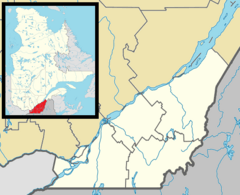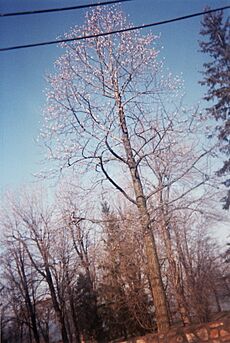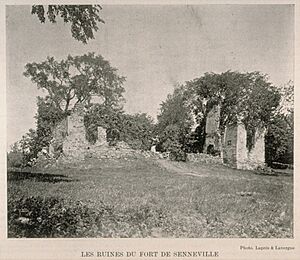Senneville facts for kids
Quick facts for kids
Senneville
|
|
|---|---|
|
Village municipality
|
|
| Village of Senneville | |
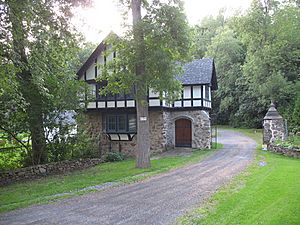
Gatekeeper's lodge at 170 Senneville Road
|
|
| Motto(s):
Né sous le lys il fleurit sous l'érable
("Born under the lily, flourishing under the maple") |
|
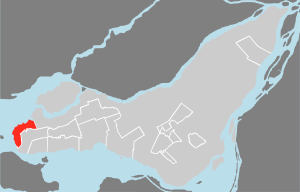
Location on the Island of Montreal
|
|
| Country | Canada |
| Province | Quebec |
| Region | Montreal |
| RCM | None |
| Founded | 1679 |
| Incorporated | 1895 |
| Merged into Pierrefonds-Senneville |
January 1, 2002 |
| Reconstituted | January 1, 2006 |
| Named for | Jacques Le Ber de St-Paul de Senneville |
| Area | |
| • Total | 18.60 km2 (7.18 sq mi) |
| • Land | 7.45 km2 (2.88 sq mi) |
| Population
(2021)
|
|
| • Total | 951 |
| • Density | 127.7/km2 (331/sq mi) |
| • Pop 2016-2021 | |
| • Dwellings | 377 |
| Time zone | UTC−5 (EST) |
| • Summer (DST) | UTC−4 (EDT) |
| Postal code(s) |
H9X
|
| Area code(s) | 514 and 438 |
| Highways | |
Senneville is a small, wealthy village located on the western tip of the Island of Montreal in Quebec, Canada. It is part of the area known as the West Island.
This village is close to the big city of Montreal. In the past, many rich Montrealers built their country homes here. Senneville has fun places like golf clubs and a yacht club. You can also visit La Ferme du Fort Senneville, which is a farm that grows organic food. The Morgan Arboretum, a special forest and bird sanctuary, was started here in 1953. It is open to everyone all year. There are also old ruins of Fort Senneville, built in 1671, but they are on private land. The oldest part of the village was named a National Historic Site in 2002 because it is so important to history.
Contents
Geology: The Land Beneath Senneville
The ground in Senneville is made of a type of rock called dolomite. Even though the rock is the same everywhere, the soil on top is very different! You can find clay soil near the northeast side and along some western shores.
Many areas further inland have sandy soil. This soil drains water quickly in some spots. However, sometimes it has trouble draining because of a hard layer that forms underground. Near the northern shore, there is a lot of glacial till. This soil is good for plants because it is rich in minerals and drains well.
The hillsides near Lake of Two Mountains are perfect for growing fruit trees and delicate plants. This is because the soil is fertile and drains well. Also, the lake helps keep the weather mild, which is great for plants.
History of Senneville
Senneville was a very important place because it was at the far western end of Montreal Island. Because of this, a wooden fort, called a stockade fort, was built there in 1671.
In 1679, a fur trader named Jacques Le Ber bought the land. He renamed it Senneville after his hometown in France. Le Ber used the fort as a place to trade furs. In 1686, he built a stone windmill there. This windmill also became a meeting point for the people who lived in the area.
A battle called the Battle of the Lake of Two Mountains happened nearby in 1689.
In 1691, the Iroquois people burned down the fort and the windmill. A new stone fort was built between 1702 and 1703. This fort stood until 1776. It was destroyed during the American Revolutionary War by soldiers from the Continental Army, led by Benedict Arnold.
The Village Municipality of Senneville was officially created on January 12, 1895. It separated from the larger area of Sainte-Anne du Bout-de-l’Isle. Senneville also had its own post office from 1911 to 1957.
On January 1, 2002, Senneville became part of the city of Montreal. It joined the borough of Pierrefonds-Senneville. However, after a vote in 2004, Senneville became an independent village municipality again on January 1, 2006.
People and Population
Senneville is a small community. In 2021, about 951 people lived there. This was a small increase of 3.3% from 2016. The village is officially recognized as a bilingual municipality since 2005. This means both English and French are important languages there.
Many people in Senneville speak English at home. About 65% of residents speak English, and 30% speak French. Other languages make up about 5%.
Education in Senneville
There are two main school boards that serve Senneville.
- The Centre de services scolaire Marguerite-Bourgeoys runs French-language public schools. They operate the École secondaire Saint-Georges.
- The Lester B. Pearson School Board (LBPSB) runs English-language public schools. The local elementary school for students in Senneville is Dorset Elementary School, located in Baie-D'Urfé.
Notable People from Senneville
Many interesting people have lived in Senneville, including:
- Ken Dryden: A famous former NHL goalie, who also became a politician and author.
- Corey Hart: A well-known singer-songwriter.
- Janina Fialkowska: A talented classical pianist.
- John Abbott: The third Prime Minister of Canada, who lived at 170 Senneville Road.
- Christopher Plummer: A famous actor, who was the great-grandson of John Abbott. He spent much of his youth in Abbott's house.
- Lino Saputo: The person who started Saputo Inc., a big Canadian cheese company.
Images for kids
See also
 In Spanish: Senneville (Quebec) para niños
In Spanish: Senneville (Quebec) para niños


